
Jaromír Krejcar: Architecture of Industrial Buildings
Almost until the 19th century, architecture can be discussed as the sole result of two fundamental components: Science (construction, to which we can, besides the obvious technical constructions, assign also all other practical knowledge that forms a solid prerequisite for dimensioning spaces and creating floor plan dispositions) and Art (forms). These two components are so tightly interconnected that it is difficult to speak of each separately; they condition each other. Construction conditions the form itself and conversely, the intended form subordinates construction without violating it. They simply form an inseparable whole. Not only the era of great styles, antiquity, Gothic, and Renaissance (although they are the most prominent), but also the stylistically declining periods, Baroque and Rococo, are characterized by this unity of construction and form.
In the 19th century, the result breaks down into two primary components, separating construction from form.*) Theoretically completely, practically, however, art has been left with only the necessary constructiveness, as far as it is indispensable for the execution of the building—but essentially it has ceased to be a creative impulse. The engineer (scientist) represents construction, and the architect (artist) represents art. This phenomenon, with a few exceptions that prove the rule, can be generalized. Let us observe the consequences that arise from this separation of science from art, the separated activity of engineers and architects.
The engineer (I mean engineers as they relate to industrial buildings) has been faced with new constructive demands due to the flourishing industry and dedicates his entire work to them. He proceeds exclusively practically without regard to the artistic aspect of the building. He is forced to work extremely economically, as dictated by the practical purpose of the enterprise. Being far removed from the romanticism of the word 'art,' he adopts the clear, mathematical logic of industry, to which he subordinates his projects for factories, railroads, stations, docks, warehouses, etc. The firm connection of his work with the ever-developing industry forces him not only to always be at the peak of the time concerning new constructive achievements but also requires knowledge in other technical fields because all inventions in these and scientific advances have a very direct influence on his work. He actually works hand in hand with inventors from all fields (after all, sometimes an invention completely conditioned a new form of a factory; just consider the invention of photography, cinema, automobile, airplane, etc.), mechanical engineers, electrical engineers, chemists, etc. He simply must always be at the forefront of modern technology—he himself becomes a mathematician of iron and concrete constructions—but even more: a mathematician regulating life in the factory, the life of an immense number of workers of modern industry. The disposition of the building is a mathematical problem for him. The sense and purpose of his work do not allow for individual inclinations. The desire for individual distinctiveness (which later, at the end of the century, became a curse for architects and still persists today) could simply not arise in the engineer, as the general utility of his work stood high above personal interest. Most of the engineer's work is anonymous (mostly bureaucratic).
Let us briefly observe the second factor in architecture: the architect—artist. His activity can be traced in private villas, apartment houses, and public buildings. Sometimes even where there is a demand for "artistic" engineering construction, the architect is invited to decorate it. If the engineer pursues a purely practical goal, which he reaches almost mathematically, the architect considers the project primarily as an artistic act, and the goal of his work is to create an artistic masterpiece. Utility is a rather unpleasant duty that must be partially adhered to. Artistic fantasy, detached from construction, dominates him to such an extent that he forgets that the building he has been commissioned to design is not intended as a reason for creating an artistic work, but primarily as shelter for a specific human life function.
Only thus can we explain the turmoil to which his artistic opinion is subjected and the changing slogans at relatively short intervals. The essence—the space does not undergo significant changes, and all attention is focused on 2 cm of facade plaster, where all artistic "revolutions" take place. The spine, which once was construction, is stiffened and stunted.
The architect has ceased to be a technician, a constructor of space, and his work remained untouched by technical progress, new constructive possibilities that by now have already become commonplace for the engineer designing an industrial enterprise. Perhaps also because private life is always ultimately forced to make do with given spaces, whether they are satisfactory or not, and technical progress is not so categorically required here as in industrial construction.
If we closely examine the results that have emerged from the separation of science and art in architecture, we see that art, which has renounced construction, has suffered more than construction (engineering), which has renounced art. Yet it can be said that this separation, which caused so much concern to aestheticians, who walked in horror around factories boasting bare construction, had an unexpected outcome. Gradually, new, interesting groupings of material began to appear in industry and buildings, later already some more detailed forms over which it was necessary to pause since the aesthetic effect of these buildings was not part of their construction program. The matter received less attention and was called technical beauty, in contrast to artistic beauty, which had no common evaluative metrics. However, over time, the number of those forms quickly increased, and they became increasingly formatively pure. — Eventually (today) we find ourselves in a world of new forms that have become the pliable language of modern life (at least one of its components, industry), for which there is no direct historical analogy in the past because they are a product of the same spirit of modern man who has connected the whole world with railroads, telegraphs, telephones, aerials, cars, and radio. Their birth has become mystically mysterious in the heat of industry, in workshops bubbling with flywheels, the whistling of conveyor belts, thousands of revolutions of turbines and dynamos—on the desk of an engineer building the shelter for machines.
Their origin is anonymous; they are the collective work of tens of thousands of workers in industry.
At first, the engineer took the matter as a purely practical problem (to build a shelter for a specific human activity and inadvertently began at the very sources from which architecture originated at all. Unburdened by academic demands and conventional assumptions of architectural beauty, he simply stood face to face with life, whose needs he had to subordinate his work to and for whose constantly developing demands he had to invent new constructions and build new spaces. Thus, industrial buildings arose for the first time, which were pure products of the modern era, buildings that fundamentally differentiate today's architecture from the past—and their beauty, so different from academic conventional beauty, is akin to the beauty of a perfect machine.
To admit the uniqueness of industrial buildings as a purely technical product cannot be done the moment the shape and configuration of their group becomes architecture, to which we are bound in an aesthetic relationship. The task is to deduce the logical consequences that arise from the architecture of industrial buildings for residential and public buildings. I believe that it is primarily necessary to renounce art in the sense in which it has been understood until today. To set aside unnecessary efforts for a modern form that diverts attention from matters far more important. The modern architect, whose focus turns entirely to the practical side of the matter, will bring his interest back to the essence of architecture; to space and its new resolution.**)
But we still see how this self-evident principle of architecture finds only slight realization. The classic example of this is the work of the vast majority of modern Czech architects, as we have been able to observe from the time of the revolution until today. In direct opposition to the taste of modern man and his sense for elegant, smooth, fine forms, a certain ornament was born, a kind of pastiche of folk ornament, which is applied without any justification to the facade. It is not an exaggeration to say that an accountant, who writes in the office of a modern commercial house on a typewriter, has more taste in his tie knot than it does in such an ornamental facade.
With constructive knowledge, modern architects have lost a direct relation to new materials, and therefore we often witness the violence with which the material is shaped into forms absolutely alien to it. However, the basis will be to turn all attention to the life of modern man, to observe it, to seek its essence, to capture its needs and to look to summarize everything in the floor plan. The technical progress, which daily brings us new things that can be used in residential buildings, is by no means fully applied, let alone that it would have an impact on the dispositions of the building and its architecture. Artistic individualism is, of course, the greatest obstacle in the path of modern architecture. It will drop of its own accord the moment the architect begins to create truly modernly and when the interest in the perfection of his work overcomes the personal vanity that drives him to uniqueness. The outward feature of modern life is the tendency towards a certain uniformity in appearance and typology. Individualism in clothing would certainly be a very ridiculous matter. In architecture, it is no less ridiculous. It is certain that new efforts in modern architecture will lead to formal asceticism and in favor of the revision of the floor plan and the overall space, which will probably receive a new organization—that will condition a new perspective on architecture.
The proof is the general movement which received theoretical expression and justification from the French Ozenfant and Jeanneret (L'Esprit nouveau). This effort for a synthesis of construction with art (construction, as I defined it at the beginning of the article), which is today called purism, is not perhaps a local phenomenon, but a broad spontaneous movement in modern art. After the artistically avant-garde of the last pre-war years and after the decorativeism of the early post-war years, interest is turning back from the surface of the building to its inner life as the sole outlet for further development. The buildings of Kotěra, Behrens, Wright, and Perret, whose spaces are linked by mathematical logic with modern life, have calmly weathered the storms of the plaster revolution, and they are rightly pointed to today as classic examples of contemporary architecture.
Finally, I would like to mention, to make myself completely understood, that the analogy between industrial buildings and private homes is not meant in the sense in which some modern outbursts of machinist theories are again formed, and it must fundamentally reject the transfer of forms (even if they are as beautiful and modern) that have arisen in industry into the architecture of residential buildings. For it is again an imposition of foreign forms, and it is equally wrong to cover the facade of a house with forms taken from an environment where they found their practical justification, and to make them decorative elements—as it is wrong to eclecticly adopt forms from historical styles. There is only one path to modern architecture, analogous to the one that the engineer took to achieve beautiful forms in industrial buildings—to subject his work entirely to purpose—to give up the striving for artistic form, and it is not paradoxical to say that only when it is not sought—will it be found.
*) The phenomenon lies deep in multiple causes, which there is no space here to discuss in detail—one of them, which has significance for us here, is the development of factory machine production and the decline of the manufactory in industry.
**) It has been said countless times and even more frequently repeated that architecture arises from the interior of the building.
In the 19th century, the result breaks down into two primary components, separating construction from form.*) Theoretically completely, practically, however, art has been left with only the necessary constructiveness, as far as it is indispensable for the execution of the building—but essentially it has ceased to be a creative impulse. The engineer (scientist) represents construction, and the architect (artist) represents art. This phenomenon, with a few exceptions that prove the rule, can be generalized. Let us observe the consequences that arise from this separation of science from art, the separated activity of engineers and architects.
The engineer (I mean engineers as they relate to industrial buildings) has been faced with new constructive demands due to the flourishing industry and dedicates his entire work to them. He proceeds exclusively practically without regard to the artistic aspect of the building. He is forced to work extremely economically, as dictated by the practical purpose of the enterprise. Being far removed from the romanticism of the word 'art,' he adopts the clear, mathematical logic of industry, to which he subordinates his projects for factories, railroads, stations, docks, warehouses, etc. The firm connection of his work with the ever-developing industry forces him not only to always be at the peak of the time concerning new constructive achievements but also requires knowledge in other technical fields because all inventions in these and scientific advances have a very direct influence on his work. He actually works hand in hand with inventors from all fields (after all, sometimes an invention completely conditioned a new form of a factory; just consider the invention of photography, cinema, automobile, airplane, etc.), mechanical engineers, electrical engineers, chemists, etc. He simply must always be at the forefront of modern technology—he himself becomes a mathematician of iron and concrete constructions—but even more: a mathematician regulating life in the factory, the life of an immense number of workers of modern industry. The disposition of the building is a mathematical problem for him. The sense and purpose of his work do not allow for individual inclinations. The desire for individual distinctiveness (which later, at the end of the century, became a curse for architects and still persists today) could simply not arise in the engineer, as the general utility of his work stood high above personal interest. Most of the engineer's work is anonymous (mostly bureaucratic).
Let us briefly observe the second factor in architecture: the architect—artist. His activity can be traced in private villas, apartment houses, and public buildings. Sometimes even where there is a demand for "artistic" engineering construction, the architect is invited to decorate it. If the engineer pursues a purely practical goal, which he reaches almost mathematically, the architect considers the project primarily as an artistic act, and the goal of his work is to create an artistic masterpiece. Utility is a rather unpleasant duty that must be partially adhered to. Artistic fantasy, detached from construction, dominates him to such an extent that he forgets that the building he has been commissioned to design is not intended as a reason for creating an artistic work, but primarily as shelter for a specific human life function.
Only thus can we explain the turmoil to which his artistic opinion is subjected and the changing slogans at relatively short intervals. The essence—the space does not undergo significant changes, and all attention is focused on 2 cm of facade plaster, where all artistic "revolutions" take place. The spine, which once was construction, is stiffened and stunted.
The architect has ceased to be a technician, a constructor of space, and his work remained untouched by technical progress, new constructive possibilities that by now have already become commonplace for the engineer designing an industrial enterprise. Perhaps also because private life is always ultimately forced to make do with given spaces, whether they are satisfactory or not, and technical progress is not so categorically required here as in industrial construction.
If we closely examine the results that have emerged from the separation of science and art in architecture, we see that art, which has renounced construction, has suffered more than construction (engineering), which has renounced art. Yet it can be said that this separation, which caused so much concern to aestheticians, who walked in horror around factories boasting bare construction, had an unexpected outcome. Gradually, new, interesting groupings of material began to appear in industry and buildings, later already some more detailed forms over which it was necessary to pause since the aesthetic effect of these buildings was not part of their construction program. The matter received less attention and was called technical beauty, in contrast to artistic beauty, which had no common evaluative metrics. However, over time, the number of those forms quickly increased, and they became increasingly formatively pure. — Eventually (today) we find ourselves in a world of new forms that have become the pliable language of modern life (at least one of its components, industry), for which there is no direct historical analogy in the past because they are a product of the same spirit of modern man who has connected the whole world with railroads, telegraphs, telephones, aerials, cars, and radio. Their birth has become mystically mysterious in the heat of industry, in workshops bubbling with flywheels, the whistling of conveyor belts, thousands of revolutions of turbines and dynamos—on the desk of an engineer building the shelter for machines.
Their origin is anonymous; they are the collective work of tens of thousands of workers in industry.
At first, the engineer took the matter as a purely practical problem (to build a shelter for a specific human activity and inadvertently began at the very sources from which architecture originated at all. Unburdened by academic demands and conventional assumptions of architectural beauty, he simply stood face to face with life, whose needs he had to subordinate his work to and for whose constantly developing demands he had to invent new constructions and build new spaces. Thus, industrial buildings arose for the first time, which were pure products of the modern era, buildings that fundamentally differentiate today's architecture from the past—and their beauty, so different from academic conventional beauty, is akin to the beauty of a perfect machine.
To admit the uniqueness of industrial buildings as a purely technical product cannot be done the moment the shape and configuration of their group becomes architecture, to which we are bound in an aesthetic relationship. The task is to deduce the logical consequences that arise from the architecture of industrial buildings for residential and public buildings. I believe that it is primarily necessary to renounce art in the sense in which it has been understood until today. To set aside unnecessary efforts for a modern form that diverts attention from matters far more important. The modern architect, whose focus turns entirely to the practical side of the matter, will bring his interest back to the essence of architecture; to space and its new resolution.**)
But we still see how this self-evident principle of architecture finds only slight realization. The classic example of this is the work of the vast majority of modern Czech architects, as we have been able to observe from the time of the revolution until today. In direct opposition to the taste of modern man and his sense for elegant, smooth, fine forms, a certain ornament was born, a kind of pastiche of folk ornament, which is applied without any justification to the facade. It is not an exaggeration to say that an accountant, who writes in the office of a modern commercial house on a typewriter, has more taste in his tie knot than it does in such an ornamental facade.
With constructive knowledge, modern architects have lost a direct relation to new materials, and therefore we often witness the violence with which the material is shaped into forms absolutely alien to it. However, the basis will be to turn all attention to the life of modern man, to observe it, to seek its essence, to capture its needs and to look to summarize everything in the floor plan. The technical progress, which daily brings us new things that can be used in residential buildings, is by no means fully applied, let alone that it would have an impact on the dispositions of the building and its architecture. Artistic individualism is, of course, the greatest obstacle in the path of modern architecture. It will drop of its own accord the moment the architect begins to create truly modernly and when the interest in the perfection of his work overcomes the personal vanity that drives him to uniqueness. The outward feature of modern life is the tendency towards a certain uniformity in appearance and typology. Individualism in clothing would certainly be a very ridiculous matter. In architecture, it is no less ridiculous. It is certain that new efforts in modern architecture will lead to formal asceticism and in favor of the revision of the floor plan and the overall space, which will probably receive a new organization—that will condition a new perspective on architecture.
The proof is the general movement which received theoretical expression and justification from the French Ozenfant and Jeanneret (L'Esprit nouveau). This effort for a synthesis of construction with art (construction, as I defined it at the beginning of the article), which is today called purism, is not perhaps a local phenomenon, but a broad spontaneous movement in modern art. After the artistically avant-garde of the last pre-war years and after the decorativeism of the early post-war years, interest is turning back from the surface of the building to its inner life as the sole outlet for further development. The buildings of Kotěra, Behrens, Wright, and Perret, whose spaces are linked by mathematical logic with modern life, have calmly weathered the storms of the plaster revolution, and they are rightly pointed to today as classic examples of contemporary architecture.
Finally, I would like to mention, to make myself completely understood, that the analogy between industrial buildings and private homes is not meant in the sense in which some modern outbursts of machinist theories are again formed, and it must fundamentally reject the transfer of forms (even if they are as beautiful and modern) that have arisen in industry into the architecture of residential buildings. For it is again an imposition of foreign forms, and it is equally wrong to cover the facade of a house with forms taken from an environment where they found their practical justification, and to make them decorative elements—as it is wrong to eclecticly adopt forms from historical styles. There is only one path to modern architecture, analogous to the one that the engineer took to achieve beautiful forms in industrial buildings—to subject his work entirely to purpose—to give up the striving for artistic form, and it is not paradoxical to say that only when it is not sought—will it be found.
*) The phenomenon lies deep in multiple causes, which there is no space here to discuss in detail—one of them, which has significance for us here, is the development of factory machine production and the decline of the manufactory in industry.
**) It has been said countless times and even more frequently repeated that architecture arises from the interior of the building.
The English translation is powered by AI tool. Switch to Czech to view the original text source.
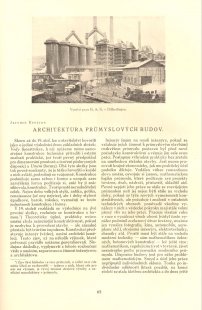
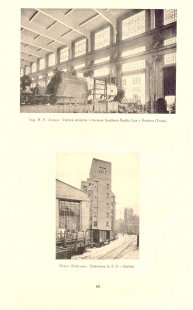
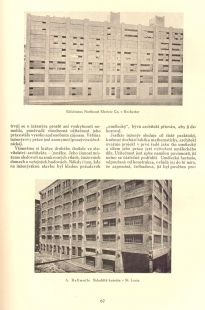
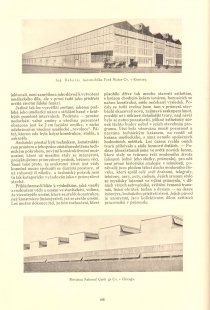
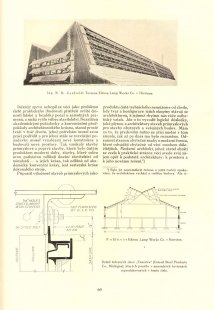
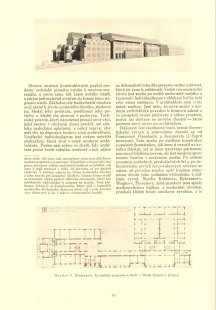
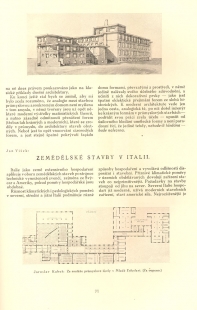
0 comments
add comment










